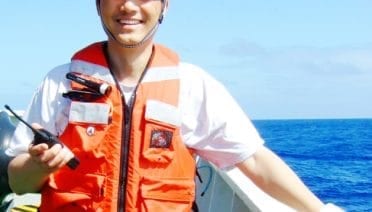Press Room
On Friday, March 6, 2009, for the first time ever, a North Atlantic right whale that had been severely entangled in fishing gear, was administered a sedation mixture that made it possible for rescuers to remove 90 percent of the…
A newly published paper by ocean scientists shows that airborne particles off the continents can have deadly effect on some marine phytoplankton. The findings, published in the online early edition of the Proceedings of the National Academy of Sciences (PNAS)…
The Woods Hole Oceanographic Institution (WHOI) and the Regional Technology Development Corp. (RTDC) of Cape Cod announced jointly today the signing of a technology transfer and entrepreneurial services agreement designed to accelerate the transfer of WHOI technology innovations to the…
The cycling of iron throughout the oceans has been an area of intense research for the last two decades. Oceanographers have spent a lot of time studying what has been affectionately labeled the Geritol effect ever since discovering that the…
Get ready to send the biology textbooks back to the printer. In a new paper published in Nature, Benjamin Van Mooy, a geochemist with the Woods Hole Oceanographic Institution (WHOI), and his colleagues report that microscopic plants growing in the…
An experiment to study the effects of naturally deposited iron in the Southern Ocean has filled in a key piece of the puzzle surrounding iron’s role in locking atmospheric carbon dioxide (CO2) in the ocean. The research, conducted by an…
Popularized by the 2005 movie “March of the Penguins,” emperor penguins could be headed toward extinction in at least part of their range before the end of the century, according to a paper by Woods Hole Oceanographic Institution (WHOI) researchers…
Did a catastrophic flood of biblical proportions drown the shores of the Black Sea 9,500 years ago, wiping out early Neolithic settlements around its perimeter? A geologist with the Woods Hole Oceanographic Institution (WHOI) and two Romanian colleagues report in…
Coral reefs around the world are in serious trouble from pollution, over-fishing, climate change and more. The last thing they need is an infection. But that’s exactly what yellow band disease (YBD) is—a bacterial infection that sickens coral colonies. Researchers…
Scientists and engineers from Woods Hole Oceanographic Institution (WHOI) and the U.S. Navy have discovered that sea turtles’ skulls and shells not only protect them from predators but also from extraordinarily powerful underwater shockwaves. The research, originally intended to help…
Using a 218-year-long temperature record from a Bermuda brain coral, researchers at the Woods Hole Oceanographic Institution (WHOI) have created the first marine-based reconstruction showing the long-term behavior of one of the most important drivers of climate fluctuations in the…
Joseph Pedlosky, a physical oceanographer with the Woods Hole Oceanographic Institution, has been awarded the Bernhard Haurwitz Memorial Lectureship at the American Metrological Society’s 89th Annual Meeting in Phoenix, Arizona, on January 14, 2009. Bernhard Haurwitz Memorial Lecturer is selected…
One of the “pumps” contributing to the ocean’s global circulation suddenly switched on again last winter for the first time this decade, scientists reported Tuesday (Dec. 23) in Nature Geoscience. The finding surprised scientists, who had been wondering if global…
Jian Lin of the Woods Hole Oceanographic Institution (WHOI) has been named a fellow of the American Association for the Advancement of Science (AAAS). Election as a fellow is an honor bestowed upon AAAS members by their peers. Lin, a…
The Woods Hole Oceanographic Institution (WHOI) has partnered with the Waitt Institute for Discovery to make deep-sea exploration technology and a world-class operations group broadly available for the oceanographic community. The collaboration, called the CATALYST Program, features the Waitt Institute’s…
On October 24, 2008, scientists from North America and Europe will meet at the Woods Hole Oceanographic Institution (WHOI) to develop the first coherent plan for studying and conserving cold-water corals in the Atlantic Ocean. The plan will lay the…
Thousands of feet below the bottom of the sea, off the shores of Santa Barbara, CA, single-celled organisms are busy feasting on oil. Until now, nobody knew how many oily compounds were being devoured by the microscopic creatures, but new…
The Woods Hole Oceanographic Institution (WHOI) has announced the formation of a new center for marine mammal research and conservation studies. The center combines scientific expertise, state-of-the-art facilities, and technological innovations to address both basic questions about marine mammal behavior,…
Researchers analyzing the May 2008 Wenchuan earthquake in China?s Sichuan province have found that geological stress has significantly increased on three major fault systems in the region. The magnitude 7.9 quake on May 12 has brought several nearby faults closer to failure and could trigger another major earthquake in the region.
King Abdullah University of Science and Technology (KAUST) today announced that Dr. James R. Luyten, one of the world’s most respected and accomplished oceanographic researchers, will become Director of the University’s Red Sea Science and Engineering Research Center (RSSERC). He…

